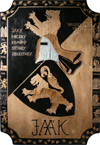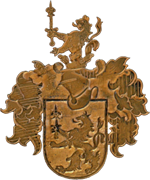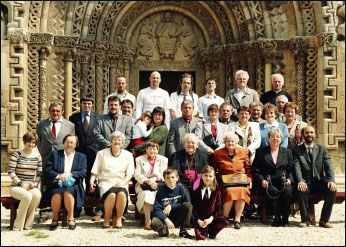The history of the Alsó-Szelestei Szelestey family
of the Jaák clan in a nutshell
 According to Simon Kézai the chronicler of László IV the Jaák clan stem from the Bavarian immigrant Veczelin of Wasserburg, who as a commander of István I. defeated Koppány. The newer researches confute the commander hood as well as the lineage. Instead arose a relationship with the ancient Hungarian Kaplony or Csák clan. For the time being there is no irrefutable evidence supporting either. Their estates mainly spread over the counties of Vas, Zala and Sopron. Approximately they owned fifty properties. Citing the words of the historian János Karácson: „At the millennial exhibition they presented the faithful replica of the façade of the Ják monastery to every attending Hungarian. Were there no written letters about these stones would talk about the glory and greatness of the founding Jaák clan”. Charter data are available since the early 13th century. By this time tha Jaáks have split up to three main branches. The richest main branch was the Pornó and Jaák Monostor. Mike from the Jaák clan 1199-1201, Hungary’s Palatine. His son Csepán I 1206-1207: Croatia’s and Slavonia’s ban the boulder of the monastery of Pornó. The next ban he was followed by was the well known Bánk. Mike’s grandson Márton of Jaák the Great, the ispán of Vasvár and Zala built the Saint George monastery and temple at Jaák. It was sanctified on the 24th of April 1256 and it still stands today. One of his sons Zlaudus 1245-1264 the bishop of Veszprém, builder of Tátika Castle. His grandson Csepán II 1274-1275 the king’s taster was the builder of Rohonc Castle. The son of ban Csepán I István joined the Cistercian order of Szentgotthárd and gifted his paternal inheritance, the monasterial patronage of Pornó along with its estates of Monyorókerék to the abbey of Szentgotthárd. By the 14th century this side of the clan disappears from our sight. According to some sources to that date lived the conscience of the entitlement to the Hungarian throne. By a contract dated 1290 we distinguish the other two branches of the Jaák clan as the Rába’s right- and left hand side bank main branch, implicitly using the situation of the estates as a basis. The country they lived at that time was called Belják (today the wider area of Jákfa). They possessed a modest substance therefore couldn’t hold national dignitary, as royal servants they had their role in the county’s public life. The Rába’s right hand side bank main branch was divided to VI sub-branches. We know three branches by name: Sitkey, Gétyey and Ölbey. From those the Sitkey’s are the most well known. In the 15th century Antal, in the 16th century Zsigmond was the alispán of Vas county. During the 14th century they could recover many of the estates of the family’s Jaák Monostor branch. The Rába’s left hand side bank main branch was divided to X sub branches. From those the following families are known: Keményegerszegi Kemény, Niczky, Jáky, Terestyénfalvy, Szentivánfalvy , Sándorfalvy and the Szelestey. In the 13th century they also built a monastery honoring Saint Michael, today the temple of Jákfa stands at its location. To its crypt the Szelestey family had burials until the end of the 19th century. As far as I know today three branches are alive. (According to the sources the Sitkey family died out in the 19th century. I have found people living by that name, but none of them responded to my letters.) The Kemény family, among whom we find county judges and head county judges of Vas county, and county scriveners. The Niczky family which rose to the highest gave Vas county four vice counts. Kristóf was awarded the title of earl in 1765. Royal chamber master and royal treasurer later master treasurer head of the king’s council and later Chief Justice. Among his sons István became Kőrös’, György Verőce’s lord lieutenant.
According to Simon Kézai the chronicler of László IV the Jaák clan stem from the Bavarian immigrant Veczelin of Wasserburg, who as a commander of István I. defeated Koppány. The newer researches confute the commander hood as well as the lineage. Instead arose a relationship with the ancient Hungarian Kaplony or Csák clan. For the time being there is no irrefutable evidence supporting either. Their estates mainly spread over the counties of Vas, Zala and Sopron. Approximately they owned fifty properties. Citing the words of the historian János Karácson: „At the millennial exhibition they presented the faithful replica of the façade of the Ják monastery to every attending Hungarian. Were there no written letters about these stones would talk about the glory and greatness of the founding Jaák clan”. Charter data are available since the early 13th century. By this time tha Jaáks have split up to three main branches. The richest main branch was the Pornó and Jaák Monostor. Mike from the Jaák clan 1199-1201, Hungary’s Palatine. His son Csepán I 1206-1207: Croatia’s and Slavonia’s ban the boulder of the monastery of Pornó. The next ban he was followed by was the well known Bánk. Mike’s grandson Márton of Jaák the Great, the ispán of Vasvár and Zala built the Saint George monastery and temple at Jaák. It was sanctified on the 24th of April 1256 and it still stands today. One of his sons Zlaudus 1245-1264 the bishop of Veszprém, builder of Tátika Castle. His grandson Csepán II 1274-1275 the king’s taster was the builder of Rohonc Castle. The son of ban Csepán I István joined the Cistercian order of Szentgotthárd and gifted his paternal inheritance, the monasterial patronage of Pornó along with its estates of Monyorókerék to the abbey of Szentgotthárd. By the 14th century this side of the clan disappears from our sight. According to some sources to that date lived the conscience of the entitlement to the Hungarian throne. By a contract dated 1290 we distinguish the other two branches of the Jaák clan as the Rába’s right- and left hand side bank main branch, implicitly using the situation of the estates as a basis. The country they lived at that time was called Belják (today the wider area of Jákfa). They possessed a modest substance therefore couldn’t hold national dignitary, as royal servants they had their role in the county’s public life. The Rába’s right hand side bank main branch was divided to VI sub-branches. We know three branches by name: Sitkey, Gétyey and Ölbey. From those the Sitkey’s are the most well known. In the 15th century Antal, in the 16th century Zsigmond was the alispán of Vas county. During the 14th century they could recover many of the estates of the family’s Jaák Monostor branch. The Rába’s left hand side bank main branch was divided to X sub branches. From those the following families are known: Keményegerszegi Kemény, Niczky, Jáky, Terestyénfalvy, Szentivánfalvy , Sándorfalvy and the Szelestey. In the 13th century they also built a monastery honoring Saint Michael, today the temple of Jákfa stands at its location. To its crypt the Szelestey family had burials until the end of the 19th century. As far as I know today three branches are alive. (According to the sources the Sitkey family died out in the 19th century. I have found people living by that name, but none of them responded to my letters.) The Kemény family, among whom we find county judges and head county judges of Vas county, and county scriveners. The Niczky family which rose to the highest gave Vas county four vice counts. Kristóf was awarded the title of earl in 1765. Royal chamber master and royal treasurer later master treasurer head of the king’s council and later Chief Justice. Among his sons István became Kőrös’, György Verőce’s lord lieutenant.
The third is the Szelestey family. Its name today is worn by the descendants of the Szelestey family from Lower-Szeleste. Since the 1240’s the seat of their estates is the eponymous village Szeleste. At this time lived the first known direct ancestors of the Jaák clan Csuna I. (Cene, Thuna, Chkwa) and his relatives Tapasz, Ják, Ebed, Gergely, Artuna, Pósa protecting Szeleste against ban File. They are protesting Béla IV against the donation of the estates. We can first see Csuna I in a charter in 1221 when together with his kinfolk they receive the villages of Urai -Újfalu, Geresd, Csánig, and Vámoscsalád from András II because their feudatory Belse accompanied him on his crusade of the Holy Land. And Gergely and Pósa came before him up to Bulgaria when he was returning. His grandson Jován (Iván, János) we can encounter in the charters as de Zelesthe in the years of 1260-70. In 1352 Jován‘s son Jakab V, in 1366 Miklós, in 1378 and in ’83 Péter of Zelesthe’s son László, king’s man in 1391 Benedek’s son Imre Count of Rábaköz and also castellan of Kapuvár. In 1428 Tibold Zelesthey vice count of Sopron county. His brother György I in 1438, later his son Balázs in 1479 and ’80, Miklós in 1502, Gergely in 1520 are king’s men. During the first part of the 16th century Bernát Szelestey is castellan of Somlyó. Maintaining a good kinship with each and every noble families of Vas county clearly shows their place both in the county’s public and social life. In the middle of the 16th century György II the son of Bernát and Eufrozina Dersiny (Berzsenyi), his father-in-law Péter Ivánczy multiple vice count of Vas county. The father-in-law of their other son Ferenc is Rafael Zichy vice count of Zala county, his brother-in-law György Zichy first Moson later Vas county’s vice count. His grandson György II his son Ádám I vice count of Vas county (1605-1608) and a delegate to the parliament (1617), the leader of the noble forces of Vas county, whose father-in-law György Marczaltőy is vice count of Moson county, his brother-in-law Miklós is the vice count of Veszprém county. His wife’s Eufrozina Marczaltőy’s grandfather is the far-famed György Thúry. The son of Ádám, Mihály Zichy, vice count of Vas and the father of György III’s wife. His cousin György Zichy is a prebend of Esztergom and an abbot of Ják. The great-great granddaughter of Ferenc’s daughter Orsolya is Ilona Zrínyi. The family slowly loses from its prominence and breaks up to multiple branches. Most of the estate remains in the hands of Sándor (his wife is Zsuzsanna Szapáry) the oldest son of Ádám I. His great-grandson Ádám II is the cup-bearer of earl Miklós Draskovich. His great-great grandson Boldizsár was the vice count of Vas county from 1742 up until his death in 1747. His son Ádám III is chief constable in Vas county and colonel of the Esterházy infantry regiment. Through his wife Magdolna Sallér he gets into relationship with György Festetics the founder of both the Georgikon in Keszthely and the Helikon, with whose wife Judit the Sallér family extinct. His son Leonárd who after 600 years already in the 19th century leaves the eponymous village Szeleste, which is acquired by the Horváth family from Szentgyőrgy through marrying into the family. In 1797 Leonard is an insurgent second lieutenant, Mihály is first lieutenant, József is captain, János is royal counselor and lieutenant-colonel. In 1790 Lajos is a member of the banderium escorting the returning Holy Crown. Boldizsár’s great-grandson Sándor is a county judge, renowned naturopath. On his estate in Úraiújfalu he keeps guestrooms for the sick and he doesn’t even accept gifts. He completes the Szelestey empirical medical handbook which was written for more than 200 years by hand. He gifts this to his assistant Mihály Német head shepherd. His son László is a ’48-er national guard major, known poet, chief scrivener of Vas county, royal counselor, county superintendent. He gets into good friendship with Petőfi, Deák, Eötvös. In 1861 he is a member of the parliament as the representative of Sárvár district. On the 15th of March 1864 together with Pál Almássy and István Beniczky he is arrested and charged with treason. With the help of Ferenc Deák and József Eötvös he is released in 1867, after that Körmend elects him as their representative. He is remembered in Uraiújfalu, Szombathely and Körmend with a street being named after him. In Uraiújfalu on the wall of his birth home a marble plaque was placed. His brother Pál died in 1893 on Szentivánfa (today a part of Uraiújfalu), and that was when the archives of the Szelestey family containing multiple thousand pages have gotten into the Archives of Szombathely. The following is written on the marble plaque of the church of Jákfa:
Many members of the Lower-Szelestey SZELESTEY FAMILY from the ancient Jaák clan which took a prominent part in the public life of Vas county and extinct on the spear-side in 1895 are resting in the vault of this church. Blessings upon their ashes!
The historical literature considers this statement as a fact. According to my family traditions and research which could be proven with decrees and birth certificates and with original letters even today many branches of our family are still living. Until now I only presented Sándor’s linage who was the son of vice count Ádám I. He was the oldest son therefore his lineage became the richest. As mentioned above this branch was truly extinct on the spear side, but one of Leonard’s daughters Franciska was by law included in the primogeniture. Her descendant Elemér Szelestey died in 2004 at the age of 87; he was the head of the Railway Masters and a dominant figure in the sports life of Vas county. His nephew László a national authority on outlaws. Ádám’s other son György III his son Ferenc in 1662 protected the Evangelic church in SZeleste against the soldiers of the recatholicized Ferenc Nádasdy. György III’s grandson Geroge IV trough his mother (Zsuzsanna Koroknay) became a landowner in Somogy county and later Chief Constable. He took part in Rákóczi’s War of Independence and because he went to exile along with Rákóczi his lands were confiscated on the grounds of high treason. His son Boldizsár Jr. was tax collector of Vas county, his other son Ferenc was a juror of Győr county, his grandson Antal was a juror of Fejér county, his great-grandson Ferenc was first lieutenant pandur of Veszprém county. One of their descendants György aged 88 lives in Linz as a retired shipmaster. András was the youngest son of Ádám I, his son László moved from Szeleste to Kisköcsk, aftrerwards László’s great-grandson János in the 1790’s moved his seat to Boba. This branch lost all their assets in the 18th century, but they held onto one thing, their evangelistic belief. They got into kinship with evangelical vicar families the Záborszkys and Döbrenteys. They survived the last 200 years rich in childbirth but poor in properties. János’ great-grandson also János during the Soviet Republic became a member of the workers’ council of Pápa. After the collapse he was arrested and later in Devecser executed. In Pápa up until the Regime Change in ’89 a street bore his name. János’ 3rd great-grandson László was the leader of the Foundation for the Evangelical Church of Boba and between 1990 and 1998 was the mayor of Boba. János’ other 3rd great-grandson also Lászlo up until his death in 1991 lived in Várpalota as a nationally known and recognized painter. An award was named after him honoring those who had excelled in contributing to the cultural life of Várpalota. His father my grandfather Antal Szelestey according to the 1951 august 15th edition of the Népújság of Veszprém county was the best electro-technician in the country. According to his grandchildren Grandpa was the country’s best story teller. The main characters of his stories were we ourselves travelling the world on a magical flying carpet. In the United States are also living Szelesteys in great numbers. Up until this point you could read about the Szelestey family of Lower-Szeleste. Their relationship with the Szelestey family of Upper-Szeleste is paradox. The situation is complicated by the fact that at a lot of places the titles are not listed and that at the same time both families had members with the same given names. According to numerous experts between the Lower/German-Szelesteys of the Jaák clan and the Upper/Hungarian Szelesteys ennobled from castle servants from Vasvár could only be neighborly connection. Based upon my research to this date I also agree with this opinion. The Upper-Szelesteys are considered the remnants of Kál’s son Vér Bulcsu, who possessed from the first land-taking. After the defeat of Koppány the Jaáks were given huge lands here and in Somogy. Many for example Gyula Balogh 19th century archivist of Vas county thinks: Domokos Szelestey seceded from the Lower-Szelestey family in the 15th century. His descendants are the Upper-Szelesteys one those branch took the name of Gosztonyi the other the Guáry. Their most famous members are: János Gosztony of Upperszeleste who used his mother’s name. First he is the bishop of Győr later Vác then Transylvania, and also chancellor of Maria Theresa. In 1527 on the orders of Ferdinánd he is assassinated. In the middle of the 16th century Sebestény Szelestey together with his brother in law are captain of the castle of Csesznek, but for the coming of the Ottoman he flees, leaving his relative alone. On the contrary János Szelestey is a famously great hero. At first he excels during the siege of Esztergom in 1588, later at Arad, in 1596 becomes captain of Lippa later he excelled during the siege of Várad. After that Zsigmond appoints him captain of the Világos castle. In 1602 general Basta orders him to be killed. In 1650 György Szelestey is royal attorney. In 1614 Miklós Upper-Szelestey is chief constable of Vas county and wife of Sára Lower-Szelestey. In the 17th century Lajos and László, in the 18th century Gábor and Miklós are royal counselors. In 1805 Miklós and János are county judges. In 1811 Miklós is royal courtsman, in 1831 royal dapifer. In 1822 Károly is county judge. In 1809 János is insurgent captain and sub notary of Vas county. Until the end of the 17th century some of the family branches are wearing the Szelesey name but after that they are living as Guáry up until this day. Their archives are kept in the Benedictine Abbey of Pannonhalma.
Of course for us for the family every family member is equally important and interesting but the extent of this note allowed me without being comprehensive only to touch upon those involved in public life. The writing of a book titled The Szelesteys is underway. In it I’m attempting as far as possible to paint the most complete picture of this age old family. Our family was not better nor worse than the others. We had our ups and downs, we had been leading and been led by, we have loved and hated, rejoiced and grieved. One thing is for sure here in our not even lucky of a sort homeland in the Carpathian-basin, we are battling with luck for 1000 years. We hope that we made more good than harm.
On the 16th of October 2004 it was an uplifting feeling being a Szelestey in Szeleste. 54 of us participated in a family reunion. We attended a reminiscent requiem in the church at Jákfa, we laid a wreath on the birthplace of László Szelestey in Uraiújfalu and we planted a tree in the botanical garden at Szeleste. On the 22th of april 2006 we held the clan reunion at the Abbey of Ják on the occasion of the 750th anniversary of the temple’s ordainment. After the mass we planted a tree in the temple garden in honor of the Kemény, Niczky and Szelestey families.
The respect and honor of the ancestors can never fade, we have to preserve and protect it, as the prehistoric man protected and preserved the fire. In this spirit with our slight strength, we the current descendants of the Jaák’s, are trying to hold a torch against the all-consuming darkness of the ever fading past.
Attila Szelestey P.
Guardian of the Past




